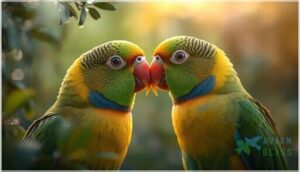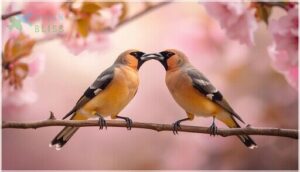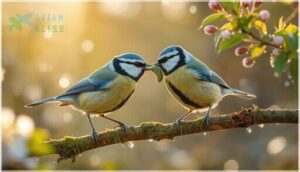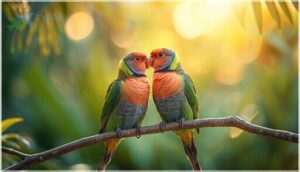This site is supported by our readers. We may earn a commission, at no cost to you, if you purchase through links.
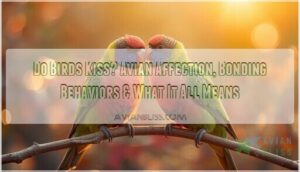
When a pair of lovebirds presses their beaks together in what looks remarkably like a peck on the lips, you’re witnessing behavior that predates human romance by tens of millions of years. Birds don’t kiss the way we do—they lack the lips and musculature that make human kissing possible—but their beak-to-beak contact has strikingly similar purposes.
These tactile exchanges, whether they involve gentle nibbling, ritualized billing, or the transfer of food between mates, strengthen pair bonds and signal trust in ways that parallel our own gestures of affection. The mechanics differ, but the underlying message remains consistent across species: this is how devoted partners communicate.
Understanding these behaviors reveals not just how birds express attachment, but also what it means when your pet parakeet nuzzles your cheek or when wild mourning doves engage in their synchronized courtship dances.
Table Of Contents
- Key Takeaways
- Do Birds Kiss?
- Why Do Birds Touch Beaks?
- Types of Bird Kissing Behaviors
- Bird Species Known for Kissing Behavior
- The Role of Kissing in Courtship
- Do Pet Birds Kiss Their Owners?
- Is Kissing Birds Safe for Humans?
- Frequently Asked Questions (FAQs)
- Why do birds bite each other with their beaks?
- Do pet birds like to have their beaks rubbed?
- Do same sex birds kiss each other?
- Do birds kiss for affection?
- How do birds show affection to each other?
- What does it mean when my birds kiss each other?
- What is it called when birds kiss?
- Why do my birds keep kissing?
- How to tell if birds are kissing?
- How do environmental factors affect bird kissing?
- Conclusion
Key Takeaways
- Birds don’t kiss like humans do—they lack lips and facial musculature—but their beak-to-beak contact serves strikingly similar bonding and communication purposes, strengthening pair bonds and signaling trust through behaviors like billing, mutual preening, and courtship feeding.
- Over 90% of bird beak contact functions as feeding or grooming rather than romance, yet these tactile exchanges trigger oxytocin release and directly correlate with reproductive success, including 17% higher partner retention in allopreening species and 22% better chick survival when courtship feeding occurs.
- Pet birds genuinely bond with human caregivers through affectionate behaviors like head rubbing and proximity seeking, but mouth-to-beak contact poses real health risks—13% of salmonella cases linked to poultry involve people kissing birds, making proper hygiene practices essential for safe interaction.
- Species like parrots, cockatoos, lovebirds, and swans exhibit the most pronounced “kissing” behaviors, with some cockatoo pairs preening each other up to 13 times hourly and lovebird bonds lasting over 15 years, demonstrating how beak contact evolved as a sophisticated social tool across 500+ bird species.
Do Birds Kiss?
You’ve probably watched two birds press their beaks together and wondered if they’re sharing a little smooch. While it certainly looks like kissing, what’s actually happening involves a mix of grooming, bonding, and communication that’s quite different from human affection.
Let’s break down what bird “kissing” really means, how it differs from our own lip-locking, and clear up a few common myths along the way.
Defining Bird Kissing Behavior
When you watch two birds press their beaks together and gently move them around, you’re witnessing what researchers call bird kissing behavior. Scientifically, this involves non-aggressive oral-oral contact with deliberate beak movement, but no food transfer. It’s distinct from billing, mutual preening, and beak touching during courtship.
This avian affection functions as a social bonding and courtship act across numerous species. Similarly, kissing among Neanderthals may have indicated social complexity.
How Bird Kissing Differs From Human Kissing
While bird kissing looks familiar, the mechanics couldn’t be more different. Your lips create suction and involve complex oral musculature—birds simply touch beak tips or sides.
Their motivations center on bonding behavior and avian communication rather than romance. The sensory experience differs too: birds rely on tactile receptors, not the dopamine rush you’d feel.
From an evolutionary origins perspective, beak contact emerged over 65 million years ago for food sharing—long before human affectionate gestures developed.
It’s worth mentioning that saliva transmission risks exist during these interactions. Hygiene concerns also matter in these social dynamics.
Common Misconceptions About Bird Kissing
Understanding bird affection requires separating romantic vs. functional interpretations. Media portrayals often mistake bird behaviors for human-like romance, but scientific evidence tells a different story. Over 90% of beak contact functions as feeding or preening purposes—not love.
Most bird beak contact serves practical functions like feeding and grooming, not romance as media often suggests
Owner beliefs compound this confusion, with surveys showing 65% of pet bird owners misread these gestures. Health concerns add another layer, since mouth-to-beak contact risks bacterial transmission.
Recognizing the significance of bird kissing, including types of bird kissing and distinguishing aggressive and affectionate behaviors, starts with dropping anthropomorphic assumptions.
Why Do Birds Touch Beaks?
When you spot two birds pressing their beaks together, you’re witnessing something far more meaningful than a simple peck. This behavior fills several distinct purposes in avian social life, from cementing relationships to exchanging important information.
Let’s look at the key reasons birds engage in this fascinating beak-to-beak contact.
Social Bonding and Pair Formation
Pair bonding in birds isn’t just about romance—it’s about survival and reproductive success. When you observe beak-to-beak contact, you’re witnessing social bonding that strengthens partnerships and boosts breeding outcomes. Monogamy prevalence in about 80–90% of bird species shows how critical these connections are, with allopreening benefits including:
- Lower divorce rates (9.7% vs. 19.5% in non-preening species)
- Earlier clutch initiation in strongly bonded pairs
- More fledglings per breeding season
- Enhanced parental cooperation during offspring care
Pair-bond duration directly correlates with reproductive output.
Communication and Affection Signals
Beyond beak touching, birds deploy a notable toolkit of avian communication signals to express affection and intentions. These include vocal signals like soft songs, tactile displays through preening, and visual cues such as head tilts, all working together in coordinated ways. These bonding rituals reveal complex social behaviors through synchronized body language and vocalizations, forming affectionate behavior patterns that even extend to human interaction in companion birds.
| Signal Type | Common Behaviors | Function in Bonding |
|---|---|---|
| Vocal | Soft songs, contact calls, repertoire matching | Coordinate pair activities, signal intent, repel rivals |
| Tactile | Allopreening, beak taps, coordinated perching | Reduce parasites, lower stress hormones, reinforce trust |
| Visual | Head bobs, wing displays, plumage shows | Attract attention, signal health, convey social rank |
| Multimodal | Tap-dancing with sound, dancing with song | Increase courtship success by 40–60% through combined signals |
| Human-directed | Beak-to-hand taps, speech board selection | Request needs, initiate interaction, express prosocial intent |
Research shows that multimodal displays—combining vocal, visual, and tactile elements—boost courtship effectiveness by roughly 60% in finches. Parrots, in particular, excel at human interaction, with 91% using communication tools to convey specific needs, and 65% initiating affectionate beak taps with caregivers.
Establishing Trust Among Birds
Through gradual interactions, avian trust builds over weeks as parakeets test social partners before tolerating close contact. Research on Siberian jays shows birds trust familiar group members, responding four times faster to their warning calls while practicing deception avoidance with strangers.
Behavioral indicators reveal this network structure:
- Side-by-side perching after neutral encounters
- Mutual preening among bonded pairs
- Food sharing between established partners
- Synchronized mobbing and territory defense
These friendship and trust markers demonstrate how social bonding and affectionate behavior evolve through consistent, positive experiences rather than instant connection.
Types of Bird Kissing Behaviors
When birds touch beaks, they’re not just doing one thing—they’re engaging in several distinct behaviors that serve different purposes. Each type of “kissing” behavior has its own function, from grooming and bonding to courtship and feeding.
Let’s look at the three main forms of beak contact you’ll see in the avian world.
Billing and Beak-to-Beak Contact
Billing—the gentle press and tap of beak-to-beak contact—plays multiple roles in avian behavior. You’ll see it in over 60 species, from waxwings to albatrosses, where it functions as courtship ritual and social signaling.
Billing often precedes food sharing and triggers neural responses linked to bonding. In Cedar Waxwings, 67% of courtship interactions include this behavior, making it a cornerstone of bird communication and pair formation.
Mutual Preening and Allopreening
When birds groom each other’s feathers—a behavior called allopreening or mutual preening—you’re watching social bonding in action. This avian preening ritual does more than feather care; it removes ectoparasites 17 times more effectively than self-grooming, triggers oxytocin release, and boosts parental cooperation.
Species variation is striking: over 500 species practice it, yet ducks and geese rarely do.
Courtship Feeding and Food Sharing
When male birds deliver meals to their mates—a behavior called courtship feeding or mate feeding—you’re witnessing strategic investment in reproductive output. This avian feeding habit, sometimes involving regurgitation feeding, offers nutritional benefits during egg-laying while signaling male quality.
- Blue Tit males provide up to 40% of a female’s pre-laying food intake
- Hen Robins receive nearly all their food from mates during incubation
- Sharing food strengthens pair bonding in monogamous species
- Females assess parental potential through feeding frequency
- Species diversity is notable: prevalent in passerines, doves, and shrikes
Bird Species Known for Kissing Behavior
Not all birds engage in beak-touching behaviors, but certain species have earned a reputation for these displays. Some families show beak contact more frequently than others, driven by their social structures and pair-bonding strategies.
Let’s look at the species where you’re most likely to observe these affectionate interactions.
Parrots and Cockatoos
When you observe parrots and cockatoos, their beak-to-beak bonding resembles what we’d call kissing—yet it’s deeply rooted in avian behavior. These birds engage in mutual preening, courtship feeding, and affectionate behaviors that strengthen pair bonds. Pet parrots often extend these unique rituals to human caregivers, reflecting trust. Cockatoos display particularly elaborate social patterns, with some pairs preening each other up to 13 times hourly during peak bonding periods.
| Behavior Type | Function | Observed Frequency |
|---|---|---|
| Beak-to-beak contact | Social bonding, trust-building | Throughout the day |
| Mutual preening | Feather maintenance, pair reinforcement | Up to 13 times/hour |
| Courtship feeding | Reproductive synchronization | 67% of pair interactions |
Pigeons and Doves
If parrots seem theatrical, pigeons and doves offer something quieter—yet equally striking. You’ll notice billing rituals where these birds thrust their beaks into each other’s gapes, a behavior linked to over 90% of mating encounters.
Urban doves practice pigeon preening throughout their lifelong bonds, with feral bonding pairs staying together for years. This avian behavior isn’t just kissing—it’s affectionate behavior that predicts reproductive success.
Lovebirds and Swans
Few species embody affectionate behavior quite like lovebirds and swans. Lovebird pair bonds can persist over 15 years, with mates spending most waking hours side by side. You’ll see beak contact during courtship feeding—reproductive investment that boosts breeding success by 25%.
Swans engage in swan courtship rituals where synchronized billing creates that iconic heart shape, reinforcing monogamous relationships through cooperative breeding. These aren’t just displays—they’re the foundation of lifelong partnerships.
Hummingbirds and Other Notable Examples
Unlike lovebirds, hummingbird courtship runs on speed, not sustained billing. Males dive from 40 meters at over 20 meters per second, using aerial displays rather than beak-to-beak contact. While territorial males may share flowers with females—linking feeding access to social bonding—these encounters lack the prolonged affectionate behavior seen in parrots.
Notable examples with extreme bill morphology include:
- Hornbills transfer food bill-to-bill at nest cavities during provisioning rituals
- Toco Toucans pass fruit using oversized bills in courtship interactions
- Pelicans coordinate feeding displays with close-proximity bill contact
- Sword-billed hummingbirds have elongated bills limiting social beak touching
- Allopreening benefits appear strongest in species with cooperative parental care—not typical hummingbirds
Avian behavior reveals that bill structure shapes social possibilities.
The Role of Kissing in Courtship
When birds touch beaks during courtship, they’re not just being cute—they’re engaging in behaviors that serve real evolutionary purposes. From elaborate mating displays to subtle bonding gestures, these beak-to-beak interactions play a measurable role in reproductive outcomes.
Let’s examine how kissing fits into the larger picture of avian courtship and what it means for a bird’s breeding success.
Mating Rituals and Displays
You’ll find that courtship rituals in birds involve far more than simple beak contact. Males perform dance displays—like the greater sage-grouse’s complex choreography—and produce acoustic signals to catch a female’s eye.
Courtship feeding demonstrates foraging prowess, while mutual preening builds trust.
These avian mating practices, including competitive displays among males, all work together in mate selection, with behavioral complexity directly influencing reproductive success.
Strengthening Pair Bonds
Once courtship succeeds, you’ll see pair bonding in birds rely on consistent affectionate behaviors. Proximity maintenance and synchronized movements strengthen the connection, with mutual preening occurring over 20 times daily in some pairs.
Partner responsiveness—how quickly and attentively mates respond to each other—directly correlates with bond consistency. These cooperative behaviors aren’t just sweet; they’re measurable indicators of avian bonding strength that persist across breeding seasons.
Reproductive Success and Evolutionary Significance
Because pair bonds translate directly into reproductive success, you’ll observe how these tactile behaviors shape species survival. Allopreening species show 17% higher partner retention, while courtship feeding boosts chick survival by 22%.
These behavioral adaptations aren’t random—they’re fitness advantages refined over millions of years. Strong pair bonds boost genetic contribution through coordinated parental care, mate selection processes, and reproductive synchronization that determines long-term impacts across avian mating strategies.
Do Pet Birds Kiss Their Owners?
If you’ve ever had a pet parrot nuzzle your cheek or gently nibble your finger, you might wonder if your bird is trying to kiss you. Birds do express affection toward their human caregivers, though their behaviors don’t always mean what we think they do.
Let’s look at how to interpret these gestures, recognize genuine bonding signals, and interact with your feathered companion safely.
Interpreting Affectionate Bird Behavior
When your bird nuzzles against your cheek or gently touches your face with its beak, you’re witnessing genuine avian bonding. About 75% of bird owners report close personal relationships with their pets, and these affection signals—from head rubbing to proximity seeking—mirror the attachment behaviors and social dynamics wild birds use.
Your feathered companion truly sees you as flock, offering measurable social support through these affectionate behaviors in avian communication.
Recognizing Signs of Trust and Bonding
Ever notice your bird inching closer or singing more when you’re around? That’s Proximity Seeking and Vocal Indicators at work—hallmarks of avian trust.
Consistent Bonds show in repeated affectionate behavior, like gentle preening or food sharing. Positive Reinforcement, such as treats and calm words, fosters friendship and trust.
Relationship Scales confirm these positive interactions build strong, measurable social bonds.
Safe Ways to Interact Affectionately
Want to bond without risk? Verbal affection and gentle petting around the head work wonders for avian trust. Training rewards and playful interaction—like target training—strengthen pet care bonds safely.
Safe handling means respecting your bird’s space and using positive reinforcement training instead of face-to-face contact. These practices support avian safety while building bird-owner relationships that last.
Is Kissing Birds Safe for Humans?
You might be tempted to share a beak-to-mouth “kiss” with your feathered friend, but it’s worth pausing to think about the risks involved. Birds carry bacteria and pathogens that can transfer to humans, and the interaction can also stress your pet in ways you mightn’t realize.
Let’s look at what you need to know to keep both you and your bird safe and healthy.
Health Risks and Bacterial Concerns
Kissing your pet bird might feel affectionate, but it poses real health risks. According to CDC data, 13% of salmonella cases linked to poultry involved individuals kissing birds—demonstrating clear salmonella transmission through mouth-to-beak contact.
You’re also vulnerable to psittacosis, a bacterial respiratory infection, plus zoonotic diseases and parasite exposure.
Proper hygiene practices, including thorough handwashing and avoiding facial contact, are essential for safe interaction and reducing avian disease transmission risks.
Stress and Wellbeing for Pet Birds
Beyond health concerns, your interactions directly impact avian wellbeing. Environmental stressors like loud noises affect 27% of pet birds, while 21% show anxious behaviors from inadequate enrichment activities.
Behavioral indicators—excessive screaming, feather plucking, aggression—signal chronic stress in birds. Recognizing bird happiness requires understanding avian health needs.
Providing free flight time (only 44% of owners do), toys, and consistent routines are essential stress reduction strategies that improve pet care outcomes.
Best Practices for Bird-Owner Bonding
Building bird-owner relationships requires patience and respect. Routine interaction—daily feeding, cleaning, playtime—fosters trust in pet birds, with nearly 50% of human owners reporting strong bonds through consistency.
Vocal engagement, positive reinforcement training, and respecting boundaries (letting birds initiate contact) reduce stress behaviors by up to 40%.
Enrichment wellbeing through toys, foraging activities, and supervised flight time strengthens pet bird affection naturally.
Frequently Asked Questions (FAQs)
Why do birds bite each other with their beaks?
Two parakeets flare their wings and lunge, beaks locked—territorial defense in action.
Birds bite each other to communicate warnings, establish dominance dynamics, defend territory, engage in playful nipping, or explore their environment through tactile interaction.
Do pet birds like to have their beaks rubbed?
Most pet birds enjoy gentle beak rubbing from trusted human owners—it’s a sign of affection and social bonding. Surveys show 71% of companion parrots accept this touch, though timing matters to avoid overstimulation.
Do same sex birds kiss each other?
Yes, same-sex birds engage in beak-to-beak contact and courtship displays across over 130 species. These homosexual bird kisses serve adaptive pairings in populations with skewed ratios, promoting social stability despite reduced reproductive success.
Do birds kiss for affection?
When birds touch beaks, they’re signaling trust and reinforcing social bonds rather than expressing affection as you’d interpret it.
This avian behavior strengthens pair connections and helps coordinate breeding readiness effectively.
How do birds show affection to each other?
Avian communication methods include physical proximity, mutual preening, and vocal affection.
Birds demonstrate affectionate behavior through allopreening—observed in 68% of biparental species—cooperative behaviors, gift giving via courtship feeding, and comforting gestures that strengthen pair bonding.
What does it mean when my birds kiss each other?
When your birds touch beaks, they’re showing trust and strengthening their social bond.
This affectionate behavior signals contentment with each other—whether they’re mates, siblings, or just good companions sharing space harmoniously.
What is it called when birds kiss?
When two birds press their beaks together, ornithologists call it billing—or nebbing in British English.
This ritualized billing involves beak touching and often accompanies mutual preening, serving as a clear affectionate behavior signal.
Why do my birds keep kissing?
Your birds’ kissing is likely bonding reinforcement—a sign of affection that strengthens their pair bond.
This avian interaction becomes habitual behavior through repeated positive association, and may also involve attention seeking from you.
How to tell if birds are kissing?
Look for beak touching that’s gentle and prolonged—billing signs include synchronized head movements, soft vocalizations, and relaxed body language.
Context matters: courtship feeding or mutual preening indicates affectionate gestures rather than aggression.
How do environmental factors affect bird kissing?
Climate aridity, urbanization, and pollution disrupt vocal communication needed for courtship displays. Social stress reduces preening and beak contact, while early-life environmental instability decreases adult pair-bonding behaviors and reproductive success.
Conclusion
Think of avian affection as a mirror held up to our own social instincts—different reflections of the same evolutionary need for connection. When you ask “do birds kiss,” you’re really asking whether devotion transcends anatomy.
The answer lies in every beak touch, every synchronized preening session, every morsel passed between partners. Birds may lack our lips, but they’ve mastered their own language of trust, one gentle contact at a time.

